Results
-
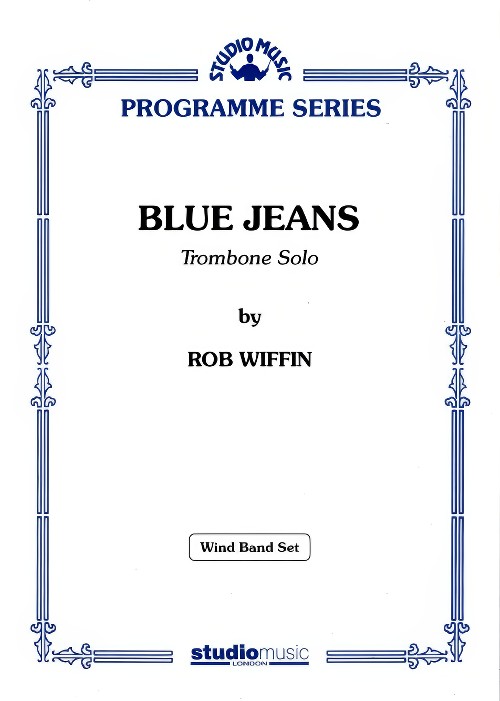 £59.95
£59.95Blue Jeans (Trombone Solo with Concert Band - Score and Parts)
In 2008 the trombonist, Chris Jeans, was invited to be a featured soloist at a British Trombone Society event. He contacted Stan Kitchen at Studio Music Company to see if he had any new material for trombone. Stan then got in touch with me, as I had already written a piece for another trombone player, Brett Baker. This piece, 'Shout' was programmed for the same event so we needed to find something new for Chris.The title 'Blue Jeans' came to my mind, thus linking a blues-style piece with the obvious reference to Chris's surname. I spoke to Chris and he liked the sound of it so then I had to go away and write a solo to match the title!I managed to get a version with piano accompaniment done in time for Chris to perform at the trombone event and have now had a chance to complete the band version. Chris is a great chap, a good friend and a wonderful trombone player so I hope people enjoy listening to this solo that bears his name.- Rob WiffinDuration: 3.30
Estimated delivery 7-14 working days
-
 £179.99
£179.99Diagram - André Waignein
The story of the origin of Diagram for Symphonic Band is a curious one. Andr Waignein was enjoying a meal together with his great friend Jean-Marie Vivier - representative director of l'Oreal Belgilux and the same man who made the performance of the famous Cantate aux Etoiles, with 750 performers possible. Jean Plaquet, an appreciated associate of both gentlemen was also present.As an acknowledgement, Andr Waignein wanted to dedicate a composition to the band where Mr. Vivier has been chairman for 20 years. In connection with this, Andr Waignein was supposed to receive some extra information about the 120 years old history of this band, which has always been led by a memberof the Vivier family. In a flash this history was presented : using a diagram Mr. Vivier drew the power-lines of this more than 100 year old band.And of course, the title was found ! The only thing left to do, was for Andr Waignein to transform this diagram into music.
Estimated delivery 7-14 working days
-
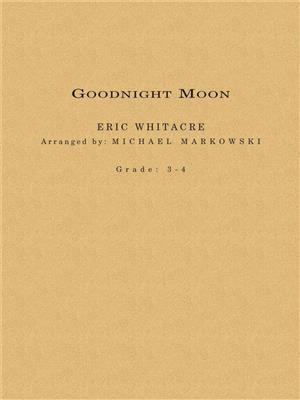 £118.99
£118.99Goodnight Moon - Eric Whitacre
Over the past few years I must have read Goodnight Moon to my son a thousand times - maybe more. Somewhere around reading number 500, I began hearing little musical fragments as I read, and over time those fragments began toblossom into a simple, sweet lullaby. I knew it was a long shot, but I asked my manager, Claire Long, to contact HarperCollins and see if they would allow the text to be set to music. To my surprise and delight they agreed - thefirst time they had ever allowed Goodnight Moon to be used in such a way. I composed the piece relatively quickly, originally setting the text for harp, string orchestra, and my son's mother, soprano Hila Plitmann. I laterarranged Goodnight Moon for SATB choir and piano. More recently, my dear friend Verena Msenbichler-Bryant arranged the piece for wind ensemble and soloist. The melody of Goodnight Moon will forever make me think of those quietnights, reading my son to sleep. -Eric Whitacre
Estimated delivery 7-14 working days
-
£134.30
Wellingtons Sieg - Ludwig van Beethoven
After the 'Battle of Vitoria', Beethoven's friend Johann Nepomuk Maelzel talked him into writing a composition for his panharmonicon (a kind of 'mechanical orchestra') to commemorating this battle. The piece, 'Wellingtons Sieg' ('Wellington's Victory') was dedicated to the Prince Regent, later King George IV and first performed in Vienna on 8 December 1813 at a concert to benefit Austrian and Bavarian soldiers wounded at the 'Battle of Hanau', with Beethoven conducting. It was an immediate crowd-pleaser and met with much enthusiasm from early concertgoers and the piece proved to be a substantial money-maker for Beethoven. 'Wellingtons Sieg' is something of a musical novelty. Besides the orchestra, on stage there are two 'sides', British and French, both playing the same instruments: Trumpets, Snare Drums, 'Canon' and Ratchet. The work has two parts: the 'Battle' ('Schlacht') and the 'Victory Symphony' (Sieges Sinfonie). The first part is programme music describing two approaching opposing armies and contains extended passages depicting scenes of battle. It uses 'Rule Britannia' for the British side and 'Marlbrough s'en va-t-en guerre' for the French side. The 'Victory Symphony' exhibits some typical Beethoven composing techniques. It can be considered as a sonata form that, stripped of the development section, comes equipped with an extended coda. Dutch arranger Andreas van Zoelen transcribed 'Wellingtons Sieg' for Symphonic Band.
Estimated delivery 7-14 working days
-
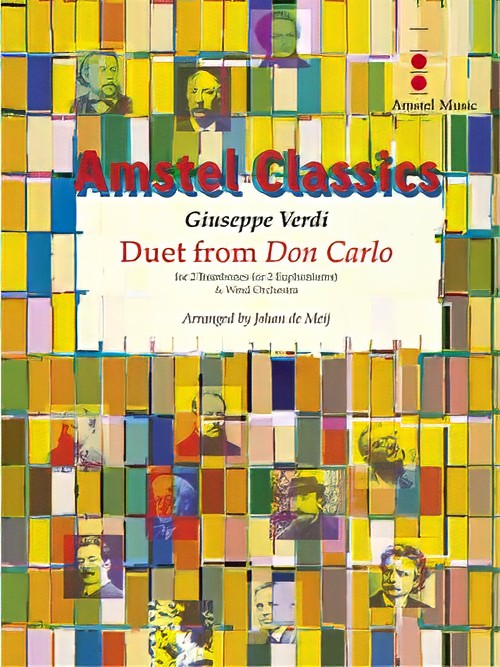 £115.00
£115.00Duet from Don Carlo (Trombone or Euphonium Duet with Concert Band - Score and Parts)
Don Carlo was originally written (title Don Carlos) as a French five-actor for the 1867 world exhibition in Paris. Later, Verdi transformed this improant grand opera into a four-acter in Italian. With its many leitmotifs, Don Carlo was 'too Wagnerian' according to French critics, although Verdi hardly knew the music by his German colleage. For the record, the composer was not happy either with the 'lifeless and cold' performance in Paris, and the drama, concerning Charles V, Philip II and crown price Don Carlo, found its way to La Scala only twenty years later. This duet, arranged by Johan de Meij, originates from the second act. While monks pray for the soul of Emperor Charles V, his grandson Don Carlo takes the stage, tormented by the fact that the woman he loves is now married to his father. Carlo's friend Rodrigo, the Margquis of Posa, has just returned from Flanders. He asks crown prince Carlo to help him ease the oppression and suffering of the Flemish people. Carlo reveals his secret: he is in love with his stepmother. Rodrigo advises him to leave Spain and to go to Flanders. The two men vow to be friends forever in the duet Dio, che nell' alma infondere (God, who wishes to instil love and hope in our souls). Duration: 4.00
Estimated delivery 7-14 working days
-
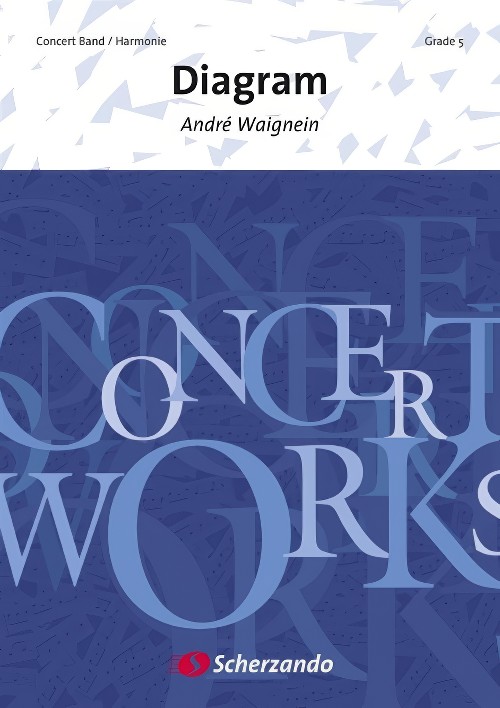 £179.99
£179.99Diagram (Concert Band - Score and Parts) - Waignein, Andre
The story of the origin of Diagram for Symphonic Band is a curious one. Andre Waignein was enjoying a meal together with his great friend Jean-Marie Vivier - representative director of l'Oreal Belgilux and the same man who made the performance of the famous Cantate aux Etoiles, with 750 performers possible. Jean Plaquet, an appreciated associate of both gentlemen was also present.As an acknowledgement, Andre Waignein wanted to dedicate a composition to the band where Mr. Vivier has been chairman for 20 years. In connection with this, Andre Waignein was supposed to receive some extra information about the 120 years old history of this band, which has always been led by a member of the Vivier family. In a flash this history was presented : using a diagram Mr. Vivier drew the power-lines of this more than 100 year old band.And of course, the title was found ! The only thing left to do, was for Andre Waignein to transform this diagram into music.Duration: 13:45
Estimated delivery 7-14 working days
-
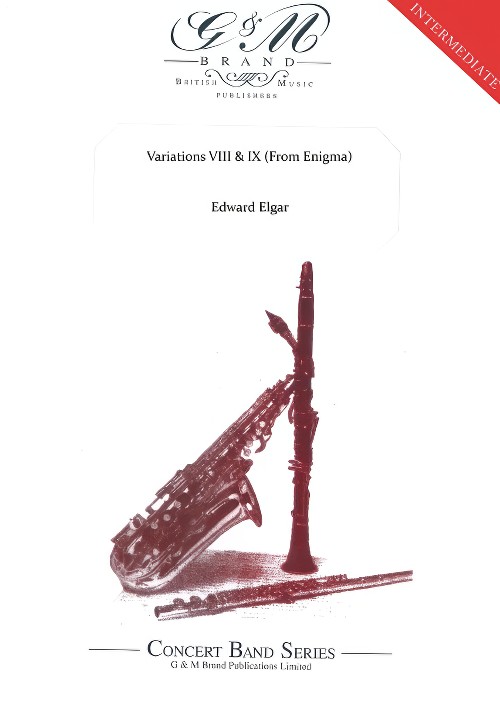 £59.95
£59.95Variations VIII & IX (From Enigma) (Concert Band - Score and Parts) - Elgar, Edward - Brand, Geoffrey
Elgar's Variations for orchestra were written during 1898-9; they are dedicated "To my friends pictured within" Each of the 14 variations is a musical portrait to one of the composer's friends. Over the 17 bar theme which inspired the Variations, Elgar wrote the word ENIGMA. Later he said, "The ENIGMA I will not explain - its "dark saying" must be left unguessed" In Variation VIII W.N. is Winifred Norbury. In 1897 local friends organised a choral and orchestral society for Elgar to conduct. The secretaryship of The Worcester Philharmonic, as the society was called, was shared by two ladies, of whom W.N.. was one She has been described as "very sedate and calm, rather like a kind governess with Elgar, but had a sense of humour - and a laugh, rather like a deep bell". Variation IX Nimrod is Elgar's deeply felt tribute toA.J.Jaeger, his German-born friend who worked for the publisher Novello and Co. His sincere support meant a great deal to Elgar. Jaeger, in German, means "hunter". Elgar concealed this in the nickname Nimrod. The variation has become extremely popular and is often played on thoughtful occasions. In this arrangement, either W.N. or Nimrod can be played alone. However, in the Variations they are linked by Elgar in an inspired manner.
Estimated delivery 7-14 working days
-
 £11.95
£11.95Variations VIII & IX (From Enigma) (Concert Band - Score Only) - Elgar, Edward - Brand, Geoffrey
Elgar's Variations for orchestra were written during 1898-9; they are dedicated "To my friends pictured within" Each of the 14 variations is a musical portrait to one of the composer's friends. Over the 17 bar theme which inspired the Variations, Elgar wrote the word ENIGMA. Later he said, "The ENIGMA I will not explain - its "dark saying" must be left unguessed" In Variation VIII W.N. is Winifred Norbury. In 1897 local friends organised a choral and orchestral society for Elgar to conduct. The secretaryship of The Worcester Philharmonic, as the society was called, was shared by two ladies, of whom W.N.. was one She has been described as "very sedate and calm, rather like a kind governess with Elgar, but had a sense of humour - and a laugh, rather like a deep bell". Variation IX Nimrod is Elgar's deeply felt tribute toA.J.Jaeger, his German-born friend who worked for the publisher Novello and Co. His sincere support meant a great deal to Elgar. Jaeger, in German, means "hunter". Elgar concealed this in the nickname Nimrod. The variation has become extremely popular and is often played on thoughtful occasions. In this arrangement, either W.N. or Nimrod can be played alone. However, in the Variations they are linked by Elgar in an inspired manner.
Estimated delivery 7-14 working days
-
£120.00
ILLYRIAN DANCES (Concert Band) - Woolfenden, Guy
Includes:I. RondeauII. AubadeIII. GigueThis suite of three dances was commissioned by the British Association of Symphonic Bands and Wind Ensembles with funds provided by West Midlands Arts. The first performance took place on 26th September 1986 at Warwick University during the fifth annual BASBWE Conference. As with Gallimaufry, some of the thematic material is adapted from music originally written for productions with the Royal Shakespeare Company.The precise location of Illyria was not important to Shakespeare; what excited him was the resonance of the word itself and the romance of all far away, make believe places. Illyria is Never Never Land and the idea of inventing dances for such a place intrigued me.The opening Rondeau has a seven bar refrain with a rhythmic twist to it, which alternates with variants highlighting most sections of the orchestra. The Aubade is a gentle dance in ternary form featuring the flutes, with a hint of the dawn chorus at the close. The final Gigue is a rondo in six-eight time, with the recurring theme also appearing in counterpoint to the many subsidiary themes.Illyrian Dances is dedicated to my old and good friend Timothy Reynish.-GW
Estimated delivery 7-14 working days
-
 £74.00
£74.00Nimrod - Edward Elgar
Nimrod is the name given to the ninth and best-known variation inEdward Elgar's Enigma Variations, an orchestral work of 14 variations on an original theme composed between 1898 and 1899. Each variation is also a portrait of one of 14 members of Elgar's family and circle of friends. A celebrated work, Nimrod is a portrait of Augustus Johannes Jaeger, who in addition to being his best friend was also Elgar's editor.The variations all represent a series of portraits and as such are entitled with a name or initials that identify the person. Biblically, Nimrod is a great hunter of the Old Testament, thus representing his muse through a play on words: Jger in German means 'hunter'. The melody appears to represent a nocturnal stroll during which the two discuss Ludwig van Beethoven's slow movements; the first eight bars, in fact, recall the beginning of the second movement of the Pathtique Piano Sonata.An arrangement of classical music signed by Franco Cesarini which stands out for its skilful and careful instrumentation.
Estimated delivery 7-14 working days
